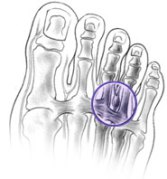 A Morton’s Neuroma is a thickening of the tissue that surrounds the nerve leading to the toes. Non-surgical treatment typically involves a cortisone injection and shoe wear modification, and is successful at providing relief for about 50 percent of patients. Repetitive injections are dangerous to the fat pad and not recommended, which is why surgery is often the optimal route if non-operative treatments are unsuccessful.
A Morton’s Neuroma is a thickening of the tissue that surrounds the nerve leading to the toes. Non-surgical treatment typically involves a cortisone injection and shoe wear modification, and is successful at providing relief for about 50 percent of patients. Repetitive injections are dangerous to the fat pad and not recommended, which is why surgery is often the optimal route if non-operative treatments are unsuccessful.
Surgery to remove the inflamed nerve is successful in more than 95 percent of patients, and it can be performed on an outpatient basis. Below, we take a closer look at how surgery is performed to address Morton’s neuroma.
Are you experiencing pain, discomfort or a stinging sensation around or near the underside of the fat pad in your feet?
If so, let Dr. Silverman help.
For more information about Morton’s neuromas, keep reading.
What Happens Before Morton’s Neuroma Surgery?
The surgical center will inform you when to arrive and how to prepare for surgery. The day of surgery you will receive regional anesthesia known as a popliteal nerve block. This is a procedure performed by the anesthesiologist prior to surgery. You will be placed on your stomach and a small needle is used to inject Novocain-like medication around the nerve in your leg. It gives complete pain relief that lasts for 12 to 36 hours. Patients report extraordinary satisfaction with this type of anesthesia. You will be given sedatives during the surgery. Rarely, patients require general anesthesia. All patients receive antibiotics just before surgery to help prevent infection.
What Happens During Morton’s Neuroma Surgery?
During the surgery you will be put into a relaxed state by the medication delivered through the I.V. A tourniquet will be placed around your calf. You will not feel the pressure because of the nerve block. An incision is made on the top of the foot in the webspace between the toes. The nerve is identified and removed. The wounds are closed with stitches, and a sterile dressing and post-operative shoe are applied.
What Happens After Morton’s Neuroma Surgery
Once your anesthesiologist is satisfied that have recovered you will be permitted to leave the surgical center. During this recovery time your family member may take your prescription to the nearest pharmacy. You will be given crutches. Take your narcotic pain control medications before falling asleep or as you feel the “numbing” effect wear off. Remember post operative pain is much easier to control with prevention. Call to schedule your post operative appointment when you feel able.
Morton’s Neuroma General Recovery Timeline
This timeline is a general guideline. Your post-operative course may vary.
| Elevation | 23 hours / day for 7 days; swelling may last over 4 months. |
| Motion | Move your toes, ankle, and knee when the block resolves. This will decrease pain and swelling, and improve healing. |
| Walking | Begin heel weight bearing after surgery and progress to unrestricted weight bearing at four weeks. |
| Bathing | Keep dressing dry. You may shower but do not bathe. |
| Pain Control | Expect to use strong narcotics for the first 3-5 days. Wean off as soon as you are comfortable using Tylenol, Motrin, or Ultram (Rx only). |
| Work | Return depends on specific demands. It is safe to return to sedentary work at 7 days post-op. Return to heavy labor will take at least 6 weeks. |
| Driving | Patients with left foot surgery may drive an automatic transmission. Patients with right foot surgery must wait until healing is adequate and they feel safe. |
Routine Clinic Visits
| 2 weeks | Suture removal. |
| 4 weeks | Wean out of post-operative sandal. |
| 6 weeks | Minimal feelings of discomfort may linger, your overall comfort level improves over several months. |
| ********** | If at any time during your post-operative period you notice any drainage or foul odor from your incision, a temperature of more than 100.4 degrees and/or increased swelling or tenderness, you should contact our office. |
| ********** | Please call our office with any further questions. |
For more helpful tips, check out these rehab exercise videos that will help you recover, or reach out to Dr. Silverman for more information!